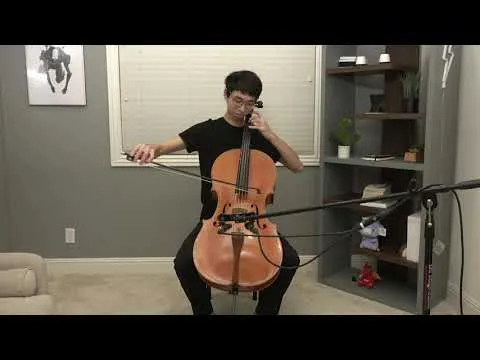Bach Suite 4, Sarabande
The Sarabande is the 4th movement in a Bach Suite. It is a dance in triple metre that originated from Central America in the early 15th century. It started out as a lively dance but after its suppression in Spain in the late 15th century, it evolved into a slower, more serious dance. It is often the most beautiful movement in a Bach suite (in my opinion) and always has incredibly elegant harmonies.

Abstract
There are a number of challenges in this Sarabande that can turn out to be universal lessons when it comes to practicing and learning a piece. Instead of writing about interpretation or technical execution this post, I wanted to write a little bit about analytical beauty and the concept of it in relationship to technique and intonation. When judging beauty or what sounds beautiful, I find myself oftentimes abiding by a set of personal preferences that leads to a perception that is clouded with prejudice. This rather adolescent like behavior often proves to be detrimental in the context of recording such a work. Plagued with thoughts of self-deprecation, I often become extremely judgmental of rather minuscule mistakes.
Melodic line
The opening melodic line (Pink highlight) is the nucleus of everything that is written in this movement. It is the basis from where one starts the construction of something beautiful. I played the melodic line rather softly in the opening and it took away from its presence and its significance. Minimizing the emotional content of the 2nd subtler repeat and taking away from some of the beauty that was being built and presented by this phrase.

Beauty derived from the essence of style
Barque dance movements all contain their own unique style. The Sarabande gains its dance motion from the triple meter, with the last beat always leading to the first beat of the next bar. The dotted rhythm naturally conveys a forward stepping motion that mimics the leading foot in a dance. Throughout my recording I waver between properly presenting the motion and floundering in a more romantic style.

Other voices
Sarabandes are often times extremely choral like with multiple voices always present. In this little section below there are 2 additional voices below the main melodic feature. The 2nd voice (Pink) and the 3rd (Blue). When listening to a 4 voice choir, if the tenor or bass are out of tune it ruins the intonation and structural integrity of the music. I focused on my bow hand in this section to maintain a full contact point on every string in order to bring out every voice equally without disrupting the flow of the upper melodic line. Intonation is always tricky here because although the bass note should be the tuning note, the intonation of the main melody can't be adjusted where it disrupts the flow from the last phrase. So the chordal intonation must be adjusted depending on the frequency that the melodic line just ended on.

Intonation
It is fair to say that one of the most important factors of making something beautiful is to have incredible intonation. The note I marked (blue) was slightly out of tune when I landed on it the second time and I adjusted it with my vibrato. I personally think that single slip-up took away from the beauty of the completion of that phrase and marred the beginning of the next. It is obviously subjective if one perceives that mistake as something that disrupts the phrase but from my own personal view, it broke the flow of the main melodic line.

Intention
The topic of intention in music has always been one that I loved talking about and discussing. Every emotion and subtle physical movement are capable of conveying a particular intention to the listener. In my recording, I made quite a few technical mistakes in my bow control during this phrase along with some out of tune notes. Although those blemishes would've typically taken away from a phrase, I think that my intention stayed true and despite my mistakes. I didn't let it disrupt the overall feeling of the phrase. It is still beautiful despite the mistakes and thats the beauty of music.

Beautiful music can be rather subjective and there is no right way of perceiving it. Oftentimes it is an emotional connection with what we hear that sparks the response from our heart that resonates with our innermost being.